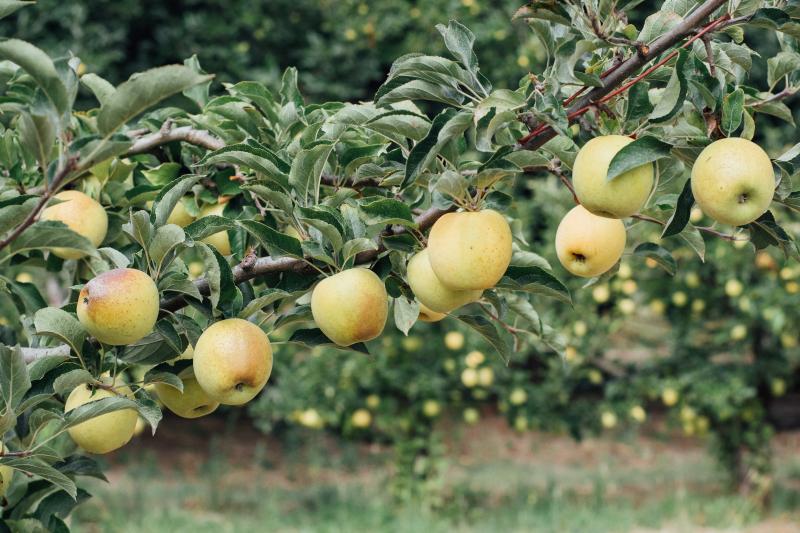It's an ill wind that blows nobody any good. When Hurricane Camille swept through Nelson County, Virginia, in 1969, the winds and flooding destroyed not only most of the town but almost the entire years-old apple orchard belonging to Clyde and Frances “Ginger” Harvey.
Among the few surviving trees was a small, half-wild seedling growing along the edges of their orchard. Years later, this lucky seedling fruited very early in summer with bright yellow-green fruits. The Harveys named this hurricane survivor after Ginger, and the Ginger Gold apple was born.
Ginger Gold apples (Malus domestica Ginger Gold) are pale yellow with a sweet, slightly tart flavor. They are excellent eaten out of hand as a fresh fruit but also cook up well into applesauce, pies, apple crisps and tarts. Unlike many other summer apples, Ginger Gold holds up well in storage. Ginger Gold apple trees are popular for home gardens because they are naturally compact, semi-dwarf trees that rarely grow taller than 12 or 15 feet.
Most apple trees need pollen from another apple tree to bear fruit. It is important that the pollinating tree blooms at the same time as Ginger Gold. Luckily, even crabapple pollen will cross-pollinate a Ginger Gold tree, and the fruit will still be delicious and sweet.
Apple trees are pollinated by insects, especially bees. Poor cross-pollination will reduce the yield of apples and can also cause misshapen fruit. You can encourage bees into your yard and garden by planting lots of native blooming plants.
Most apple trees are sold bare root, with no soil on the roots. Plant bare-root apple trees in early spring as soon as you can dig the soil. You may want to soak the roots in water about 24 hours before planting. Potted apple trees can be planted anytime during the growing season.
Ginger Gold apple trees produce best when grown in full sun, with six hours or more of direct sunlight daily. All fruit trees grow best in well-drained soil, with light- to medium-textured soils the best. Avoid planting apple trees in heavy clay soil or where water collects and the ground stays soggy. This can lead to root rot.
Space your fruit trees several feet apart so they have good air circulation. This will let the leaves dry quickly after rainfall and reduce the danger of fungal leaf diseases. Avoid planting in a so-called frost pocket, an area where cold air settles in low-lying spots. The side of a hill is ideal.
The best soil pH is 6.0 to 6.5, but apples will do just fine in a pH range of 5.5 to 7.0. Dig a hole about twice as wide as the root system and 2 feet deep. Put a bit of the loose soil back into the hole and loosen the soil on the walls of the planting hole so the roots can easily grow sideways as well as down.
Spread the roots out, taking care they are not twisted or overly crowded in the hole. Firm the soil to make sure it covers the roots and remove air pockets. Because most apple trees are grafted, be sure the graft union is at least 4 inches above the soil line. You can spot the graft union because of the swelling at the junction.
Never add fertilizer when you plant apple trees, as you can burn the roots and kill the tree. Water your newly planted Ginger Gold trees regularly, especially if they are grown on semi-dwarfing or dwarfing rootstocks.
If you use mulch, pull it away from the trunk to keep rodents from nesting in it and chewing on the bark.
Plant a Ginger Gold apple tree, and you will have sweet, crisp-tart apples early in the year. This hurricane survivor will live long and prosper.




















































